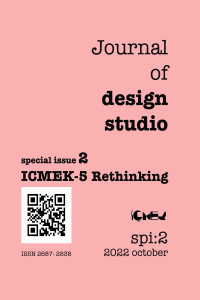Recoding Landscape Education: Research-Based Design Studio Approach
Recoding Landscape Education: Research-Based Design Studio Approach
Landscape design studio, Landscape Design Education, Design Pedagogy Research-based design, Landscape Memory,
___
- Antrop, M. (2013). A Brief History of Landscape Research. In P. Howard, I. H. Thompson, & E. Waterton (Eds.), The Routledge Companion to Landscape Studies (Vol. 46, pp. 376–381). London, New York: Routledge.
- Auge, M. (1995). Non - Places: An Introduction to an Anthropology of Supermodernity. London: Verso. Retrieved from https://doi.org/10.1177/030981689606000111
- Aydınlı, S., & Akpınar, I. (2003). Heraclitus & the Design Studio. ITU Journal Series A: Architecture, Planning, Design, 58–72.
- Freire, M. (2013). Landscape design education: challenges and proposals. In International Scientific Conference Landscape and Imagination - Towards a new baseline for education in a changing world (pp. 393–396).
- Güler, A. (2019). Peyzajın Hafızasını Oluşturan Kodlar ve Peyzaj Tasarımı Pratiğindeki Yeri: Bir Model Önerisi. İstanbul Teknik Üniversitesi.
- Güler, A., & Eşbah Tunçay, H. (2021). A Model Proposal to Read the Memory Strata Written on the Landscapes. In Ö. Demirel & E. Düzgüneş (Eds.), Landscape Research-I (1st ed., pp. 294–314). Lyon: Livre de Lyon All.
- Halifeoğlu, F. M., & Dalkılıç, N. (2006). Mardin-Savur Geleneksel Kent Dokusu ve Evleri. Uludağ Üniversitesi Mühendislik-Mimarlık Fakültesi Dergisi, 11(1).
- Hoskins, W. G. (1955). The Making of the English Landscape. London: Little Toller Books.
- Jørgensen, K., Stiles, R., Mertens, E., & Karadeniz, N. (2020). Teaching landscape architecture: a discipline comes of age. Landscape Research. Retrieved from https://doi.org/10.1080/01426397.2020.1849588
- Karagülle, C., & Demir, Y. (2010). Yerel verilerin konut tasarım sürecinde değerlendirilmesi: Mardin örneği. İTÜ Dergisi, 9(2), 83–94.
- Keswani, K. (2019). Urban Design Studio Pedagogy: Thinking About Informality. New Design Ideas, 3(2), 113–123.
- Milburn, L.-A. S., & Brown, R. D. (2003). The relationship between research and design in landscape architecture. Landscape and Urban Planning, 64, 47–66.
- Milovanovic, J., & Gero, J. (2020). Modeling Design Studio Pedagogy: A Mentored Reflective Practice. In Proceedings of the Design Society: DESIGN Conference (Vol. 1, pp. 1765–1774). Cambridge University Press. Retrieved from https://doi.org/10.1017/dsd.2020.118
- Montarou, C. (2006). The unarticulated dialogue in the creative process. In K. Jorgensen, N. Karadeniz, E. Mertens, & R. Stiles (Eds.), The Routledge Handbook of Teaching Landscape (pp. 218–219). Oxon: Routledge.
- Relph, E. (1976). Place and Placelesness. London: Pion.
- Salama, A. M. (2007). Design Studio Pedagogy: Horizons for the Future. Retrieved from https://www.researchgate.net/publication/303079610
- Salama, A. M. (2016). Spatial design education: New directions for pedagogy in architecture and beyond. Spatial Design Education: New Directions for Pedagogy in Architecture and Beyond. Taylor and Francis Inc. Retrieved from https://doi.org/10.4324/9781315610276
- Salama, A. M. (2021). Transformative pedagogy in architecture and urbanism. Transformative Pedagogy in Architecture and Urbanism. Taylor and Francis Inc. Retrieved from https://doi.org/10.4324/9781003140047
- Schön, D. A. (1988). Toward a Marriage of Artistry & Applied Science In the Architectural Design Studio. Journal of Architectural Education, 41(4), 4–10. Retrieved from https://doi.org/10.1080/10464883.1988.10758496
- Stahlschmidt, P., Swaffield, S., Primdahl, J., & Nellemann, V. (2017). Landscape Analysis Investigating the Potentials of Space and Place. Oxon: Routledge.
- Swaffield, S., & Deming, M. E. (2011). Research strategies in landscape architecture: Mapping the terrain. Journal of Landscape Architecture, 6(1), 34–45. Retrieved from https://doi.org/10.1080/18626033.2011.9723445
- Treib, M. (2006). The Landscape of Landscape History. In K. Jorgensen, N. Karadeniz, E. Mertens, & R. Stiles (Eds.), The Routledge Handbook of Teaching Landscape (pp. 191–203). Oxon: Routledge.
- Tunçer, M. (2013). Mardin’in Korunması ve UNESCO Dünya Miras Listesi’ne Girmesi. Idealkent, 9.
- Yayın Aralığı: Yılda 2 Sayı
- Başlangıç: 2019
- Yayıncı: Orhan HACIHASANOĞLU
Recoding Landscape Education: Research-Based Design Studio Approach
Design Practices for Flood Resilience in Istanbul: Case of Kadiköy Waterfront
Doga Dinemis AMAN, Ayşe Ceren GÜLER, Neşe GANİÇ SAĞLAM, Işılay AKKOYUN TEKCE, Hande TUNÇ, Orhan HACİHASANOGLU
New Approaches on Urban Agriculture: A Case Study in Ataköy
